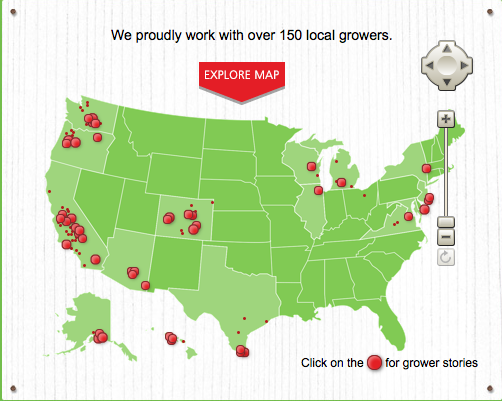A visiting cousin muttered: “I don’t know why anyone would want to grow all this stuff when you can just go to the store and buy it!” He’s not alone since many people don’t like to get dirty or slog around in the cold, rain or muggy weather doing “gardening things”. Even during the Great Wars, it took a lot of government propaganda to get people on board with the necessity to be responsible for raising their own food so that commercial farms could concentrate on the war effort.
Take a look at this map of “local growers” from Safeway grocers and notice how few of those resources are located near Maryland. Add the cost of trucking that produce from the Pacific Coast, the Southwest and Gulf to bringing those things to our local store.
Now factor in the vagaries of climate which seems to be topsy-turvy these days. Here’s a headline from May 12, 2014 out of Denver local news:
“Colorado farmers fear record low temps; overnight lows could result in millions in crop losses“
WELD COUNTY, Colo. – A prolonged cold snap overnight Monday into Tuesday could result in millions of dollars in crop losses along Colorado’s Front Range and Eastern Plains. Depending on how cold it gets, consumers could be paying a whole lot more for produce this summer.
That’s because many young plants are already above ground and could freeze and die Tuesday morning.Dave Petrocco is a third generation farmer in the Brighton and LaSalle areas, and he knows vegetables.”We grow green beans, turnip greens, mustard greens, collard greens. We also grow green and red romaine lettuce, spinach, onions,” said Petrocco.
***
Then, here’s an excerpt out of an April 2014 article from NPR (Hotlink provided below):
“California’s Drought Ripples Through Businesses, Then To Schools”
Cannon Michael runs an 11,000-acre farm in California’s Central Valley. His family has been farming in the state for six generations. Michael’s multimillion-dollar operation usually provides a wealth of crops including tomatoes, onions and melons. But recently, he’s pretty pessimistic about work.
“It is going to be a year that’s probably, at best, maybe break even. Or maybe lose some money,”
Michael says about one-fifth of the land will lie fallow this year. So come harvest season, he won’t be able to hire as many people to work the fields. The reason that Michael and farmers all around the valley are cutting back is California’s severe and ongoing drought.
“Without surface water, it’s all a big strain, and people are finding whatever means they can to survive,” he says.
Running On Empty
Nearly half of the country’s fruits, nuts and vegetables come from California, a state that is drying up. According to the U.S. Drought Monitor, the entire state is considered “abnormally dry,” and two-thirds of California is in “extreme” to “exceptional” drought conditions.
It seems to me that anyone who pooh-poohs knowing how to grow your own produce and preserve it while being faced with rising prices and stagnant incomes may be whistling a different tune in the future.



